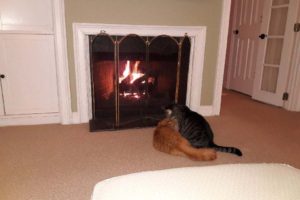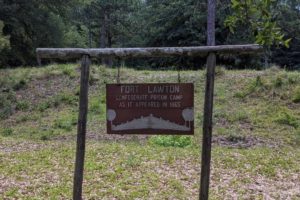As mentioned in part 1 of our southeast swing, this past summer Hallmark Channel filmed a movie in the Great Smokey Mountains National Park. Some of it was filmed in the Oconaluftee Indian Village in the town of Cherokee. So of course we had to go to the village, and we are so glad we did. It’s just outside of town close to the theater where the play “Unto These Hills” is available during the summer. This play shows the Cherokee history up to the time of the Trail of Tears. Barney saw this play as a child when he visited this area with his family, but we’ll have to come back so I can see it (before the first of September).

Paul’s for lunch



Oconaluftee Indian Village


The village is a replica of an 18th-century eastern Cherokee community; it opened its doors in the summer of 1952 and is located along the Oconaluftee River in Cherokee, North Carolina. Its goal is to immerse visitors in the history and culture of the Cherokee People. As we walk along the paths, we’ll learn about their traditional arts, weaponry, government ceremony, dances, and times of peace and war.

By mastering their traditional arts and crafts, preserving the Cherokee language, and keeping songs and dances alive, the village continues to preserve history and culture for future generations of Cherokee People.



The woman in the next picture was our guide. As an actor by training, she knew how to keep our attention as we walked along. While everyone in a town would know how to do each skill that we’ll be seeing, they could choose each day what they wanted to do.
bead work


pottery

They’d shape their pots, make a fire, and put the pots around the fire with the opening toward the fire. As the pots were heated and the fire turned more to coals, they pots would be put into the fire area.

woodworking



basket weaving

weapons for hunting and fighting



homes
In each village, there were 30-60 homes, a plaza, a town square, and a council house large enough to hold all the villagers during a village meeting. A wall of tall poles tied together surrounded each village.

We were surprised that they had such permanent homes. A piece of information I found on a website was that the Cherokee had winter and summer homes built for that type of weather. Most of the Cherokee would stay in the same area for years rather than traveling around like the Plains Tribes.




trading posts

making a canoe

Then came the hard work of cutting out the rest of the canoe. Some of canoes were 60 feet long and 5 feet wide. The Cherokee people traveled as far as Central America and Canada, using rivers for transportation. The canoes were large enough to carry items to trade and bring home.
outside meeting area for ceremonial dances
This area in the next picture would be made of sand with a built-up edge to keep the area sacred that everyone would honor. One of the corners is open so the dancers could enter. Around the circle are 7 canopied areas, 1 for each clan, so clans could sit together.
Each clan had a special role in the village: (from visitcherokeenc.com)
- Blue (A NI SA HO NI) – Historically, this clan made medicine from a blue-colored plant to keep the children well. They are also known as the Panther or Wild Cat Clan.
- Long Hair (A NI GI LO HI) – Also known as the Twister, Hair Hanging Down or Wind Clan. They wore elaborate hairdos and walked with a proud, twisting gait. Clan members are regarded as peacemakers; and Peace Chiefs were often from this clan. Prisoners of war, orphans of other tribes, and others with no Cherokee tribe were often adopted into this clan, thus a common interpretation of the name “Strangers.”
- Bird (A NI TSI S KWA) – historically known as messengers. The belief that birds are messengers between earth and heaven, or the People and Creator, gave the members of this clan the responsibility of caring for the birds.
- Paint (A NI WO DI) – historically known as prominent healers. Medicine was often “painted” on a patient after harvesting, mixing, and performing other aspects of the ceremony. Clan members made red paint and prepared teas for vapor therapy specific to each ailment.
- Deer (A NI KA WI) – historically known as fast runners and hunters. Even though they hunted game for subsistence, they respected and cared for the animals while they were living among them. They were also known as messengers on an earthly level, delivering messages from village to village, or person to person.
- Wild Potato (A NI GA TO GE WI) – historically, members of this clan were known to be “keepers of the land” and gatherers of the wild potato in swamps along streams. They are also known as the Bear, Raccoon, or Blind Savannah Clan.
- Wolf (A NI WA YAH) – the largest and most prominent clan throughout time. During the time of the Peace Chief and War Chief government setting, the War Chief came from this clan. Wolves are known as protectors.


importance of the clans
“The Cherokee society is historically matrilineal, meaning clanship is passed through the mother [like the Jewish nation]. Among the Cherokees, women were considered the head of household, with the home and children belonging to her should she separate from her husband. The knowledge of a person’s clan is important for many reasons; one of those reasons is that among Cherokee traditionalists today, it is forbidden to marry within one’s clan as clan members are considered brothers and sisters. Knowledge of a person’s clan is also important when seeking spiritual guidance and in traditional medicine ceremonies, as it is necessary to name the clan.” (from visitcherokeenc.com)
council house
“Each village had a council house where ceremonies and tribal meetings were held. The council house was seven-sided to represent the seven clans of the Cherokee: Bird, Paint, Deer, Wolf, Blue, Long Hair, and Wild Potato. Each tribe elected two chiefs–a Peace Chief who counseled during peaceful times and a War chief who made decisions during times of war. However, the Chiefs did not rule absolutely, decision making was a more democratic process, with tribal members having the opportunity to voice concerns. (nps.gov on the Cherokee nation in the Great Smoky Mountains)


Such an interesting way to show us the history of the Cherokee. Thanks for joining us. The next post will show you other highlights around Franklin, NC.




